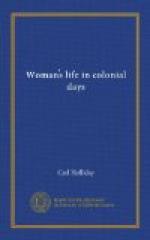The old story of how the earlier settlers purchased their wives with from one hundred twenty to one hundred fifty pounds of tobacco per woman—a pound of sotweed for a pound of flesh,—is too well known to need repetition here; suffice to say it did not become a custom. Nor is there any reason to believe that marriages thus brought about were any less happy than those resulting from prolonged courtships. These girls were strong, healthy, moral women from crowded England, and they came prepared to do their share toward making domestic life a success. American books of history have said much about the so-called indented women who promised for their ship fare from England to serve a certain number of months or years on the Virginia plantations; but the early records of the colonies really offer rather scant information. This was but natural; for such women had but little in common with the ladies of the aristocratic circle, and there was no apparent reason for writing extensively about them. But it should not be thought that they were always rough, uncouth, enslaved creatures. The great majority were decent women of the English rural class, able and willing to do hard work, but unable to find it in England. Many of them, after serving their time, married into respectable families, and in some instances reared children who became men and women of considerable note. There can be little doubt that while paying for their ship-fare they labored hard, and sometimes were forced to mingle with the negroes and the lowest class of white men in heavy toil. John Hammond, a Marylander, who had great admiration for his adopted land, tried to ignore this point, but the evidence is rather against him. Says he in his Leah and Rachel of 1656:
“The Women are not (as reported) put into the ground to worke, but occupie such domestique imployments and housewifery as in England, that is dressing victuals, righting up the house, milking, imployed about dayries, washing, sowing, etc., and both men and women have times of recreations, as much or more than in any part of the world besides, yet some wenches that are nasty, beastly and not fit to be so imployed are put into the ground, for reason tells us, they must not at charge be transported, and then maintained for nothing.”
Of course among the lower rural classes not only of the South, but of the Middle Colonies, a wedding was an occasion for much coarse joking, horse-play, and rough hilarity, such as bride-stealing, carousing, and hideous serenades with pans, kettles, and skillet lids. Especially was this the case among the farming class of Connecticut, where the marriage festivities frequently closed with damages both to person and to property.
X. Romance in Marriage
Perhaps to the modern woman the colonial marriage, with its fixed rules of courtship, the permission to court, the signed contract and the dowry, seems decidedly commonplace and unromantic; but, after all, this is not a true conclusion. The colonists loved as ardently as ever men and women have, and they found as much joy, and doubtless of as lasting a kind, in the union, as we moderns find. Many bits of proof might be cited. Hear, for instance, how Benedict Arnold proposed to his beloved Peggy:




